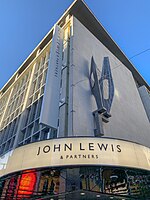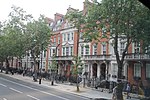Grosvenor Gardens House
Apartment buildings in LondonBelgraviaCommons category link is locally definedGrade II listed buildings in the City of Westminster

Grosvenor Gardens House is a Grade II-listed mansion block at 23–47 Grosvenor Gardens, Belgravia, London. Queen Elizabeth The Queen Mother may have been born there in 1900. David Niven was born there in 1910, and William Henry Blackmore killed himself there in 1878. As of March 2017, the building is the subject of a £132-million High Court trial for damages brought against Christian and Nick Candy.
Excerpt from the Wikipedia article Grosvenor Gardens House (License: CC BY-SA 3.0, Authors, Images).Grosvenor Gardens House
Grosvenor Gardens, London Victoria
Geographical coordinates (GPS) Address External links Nearby Places Show on map
Geographical coordinates (GPS)
| Latitude | Longitude |
|---|---|
| N 51.4971 ° | E -0.1454 ° |
Address
Grosvenor Gardens House
Grosvenor Gardens 35-37
SW1W 0BS London, Victoria
England, United Kingdom
Open on Google Maps










